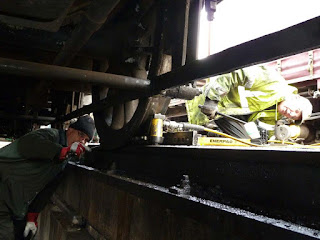The device consists of a frame with two hydraulic pistons attached. The pistons are connected by pipes to a hydraulic pump. With the tender positioned over a pit, the frame is placed under each wheel in turn. Due to the magic of hydraulics, the device allows a person to operate the pump by hand and produce enough force to lift the tender wheel. The pressure is then read from a gauge on the pump.
 |
| Gilbert operating the hydraulic pump |
This is a two man job. One person operates the pump, while a second person is down in the pit below the tender. While the pump is operated, the person in the pit uses feeler gauges to determine when the wheel has just started to lift from the track. The pressure is recorded, and the processs is repeated for the other five wheels.
 |
| Geof in the pit checks for the wheel to lift |
With readings from each wheel it can be determined whether the weights are even, and if not the spring hangers can be adjusted to alter the weight on the wheel. Frequently adjusting the weight on one wheel will change the weight on the others. The weighing, adjusting, weighing, adjusting process is repeated until all of the wheels are even. This can take some time!

No comments:
Post a Comment